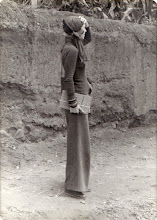In 1977, a decade after Guy Debord and the International Situationists called for the détournement of spectacular imagery to denounce its own ideological focus and its abstraction of life to the level of managed appearances, Douglas Crimp curated the show "Pictures" at SoHo's Artists Space. The "current generation of younger artists" had grown up seeing television and media saturation as a given rather than an imposition, a constant in their reality. In the seminal show of the Pictures Generation, Jack Goldstein, Robert Longo, Phillip Smith, Sherrie Levine, and Troy Brauntuch addressed the dispersal and plurality of art and representation via appropriation rather than rejection. Re-presenting the representation as such, a copy of a copy (of a copy, e.g reality), not only exposed the elusive fabric of reality and the duplicitous representations that compose the surrounding world, but also rationally deconstructed Foucault's "rationally constructed author-function".
“If, as the historian Eric Hobsbawm writes, "all 'postmodernisms' had in common an essential skepticism about the existence of objective reality, and/or the possibility of arriving at an agreed understanding of it by rational means," and thus "tended to a radical relativism" one only has to think of Barthes' remark that "the realistic artist never places 'reality' at the origin of his discourse, but ... only a succession of copies" to get the point -- then art also seems relative to whatever one irrationally wants it to be.””, writes Kuspit in 2001.
Ironically, Cindy Sherman, who would go on to epitomize postmodern photography and practice, worked at the front desk of Artists Space but wasn’t included in the show. Later worked into the “Pictures” text, Crimp described her manipulated scenes using photography’s “seamless vision of reality” as a way to expose its own nature as subjective and indeed her own nature as a constructed, performed representation. Her presence as a succession of fictional personae in managed shots imitating film stills effectively took Debord up on détournement, and then some.
“In a world of scientific and technological triumphs, I don't see any other purpose for art than to symbolize subjective states, which still have their mysteries. They can perhaps be understood and mastered, in however personal and limited a way, through art.” – Kuspit, 2001. If the symbolization of subjective states and the rescuing of creativity from the dead end of objective-linguistic irony constitute Kuspit’s only hope for postmodernism, Sherman’s tentative theory is revelatory of photography’s creative power: "This is my theory," she says tentatively, "it prepares you psychically for the potential for violence in your own life. Or your own death. I think it's also a way to be removed enough from it to even laugh at it. It just further prepares you for something that you don't look forward to having to experience." Although appropriation in itself was not exactly groundbreaking at the time, and certainly not in the light of art history, as artists slipped on the styles of the past like masks, emphasizing the “surface” quality that had become the trademark of postmodernism, they also actively reappropriated the tools of media and explored the contingencies of their own identities, often reading the very photos themselves against the grain of ideology.






Aucun commentaire:
Enregistrer un commentaire